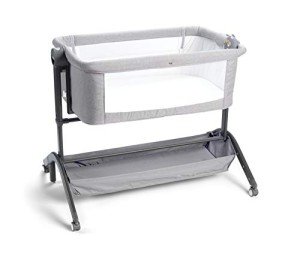The Versatility of Bedside Cots: A Comprehensive Guide
Bedside cots have actually acquired popularity among new parents for their multifunctional design and ease of use. These versatile sleeping services permit caretakers to keep their newborns close while making sure safety and convenience. In this post, we will explore the features, advantages, and numerous choices readily available in the market for bedside cots, as well as supply responses to regularly asked questions.
What is a Bedside Cot?
A bedside cot, frequently referred to as a co-sleeper or sidecar crib, is a small bed designed to be connected to the moms and dad's bed. This design enables parents to have their baby within arm's reach while maintaining a separate sleeping space. Many bedside cots are adjustable in height, making it easier to align them with the height of the parents' bed.
Key Features of Bedside Cots:
- Attachable Design: Most bedside cots feature a safe and secure attachment mechanism to the parent's bed, guaranteeing safety for the baby.
- Adjustable Height: Many models enable height changes to match the moms and dad's bed mattress.
- Breathable Mesh Walls: To improve visibility and air flow, most styles include mesh sides.
- Compact Size: Bedside cots are generally smaller than standard cribs, making them perfect for smaller spaces or easy portability.
- Security Features: Safety is paramount, and numerous bedside cots include features such as locking mechanisms and durable frames.
Advantages of Bedside Cots
Bedside cots not only promote safe co-sleeping practices but also bring a myriad of advantages that improve the parent-child bonding experience. Here are a few of the most substantial advantages:
1. Close Proximity
Having the baby close permits mothers to respond quickly to their infant's requirements, thereby promoting attachment and ensuring a soothing environment for the kid.
2. Easier Nighttime Feeding
Breastfeeding mothers find bedside cots profoundly practical as they eliminate the need to rise for nighttime feedings. This can cause a more restful night's sleep for both the parent and the infant.
3. Security and Comfort
Bedside cots provide the security of a separate sleeping space while still developing the intimacy of co-sleeping. This plan is frequently advised by pediatricians to minimize the danger of SIDS (Sudden Infant Death Syndrome).
4. Space-Saving
For families living in smaller homes or houses, bedside cots are a space-efficient service compared to conventional cribs.
5. Adaptability for Growing Babies
Lots of bedside cots can shift into a standalone crib and even a playpen as the baby grows, making sure long-term use.
Types of Bedside Cots
Before purchasing a bedside cot, it is essential to comprehend the numerous types available. Below are the most common varieties:
- Standard Bedside Cots: These connect directly to the parents' bed and can be quickly moved.
- Travel Bedside Cots: Portable designs are light-weight and foldable, making them perfect for travel or trip.
- Convertible Cots: These can be transformed into a full-size crib or play area, offering extended usage.
- Swivel Cots: Some designs include a turning design, allowing parents to quickly reach the baby without needing to raise them.
Buying Considerations for Bedside Cots
When shopping for a bedside cot, it is crucial to take certain elements into account:
- Safety Certifications: Always look for security standards from respectable companies such as the Consumer Product Safety Commission (CPSC).
- Alleviate of Assembly: Look for models that are easy to establish and protect to the bed.
- Material Quality: The products utilized in the cot needs to be non-toxic and tough adequate to stand up to daily use.
- Price Range: Depending on functions and design, prices can vary significantly. Side Sleeping Crib spending plan and pick a cot that satisfies your requirements.
- User Reviews: Consider reading consumer testimonials to assess the cot's durability and performance.
A Comparison Table of Popular Bedside Cots
| Brand | Type | Rate Range | Weight Capacity | Special Features |
|---|---|---|---|---|
| Chicco Next2Me | Basic | ₤ 200-₤ 300 | 9-36 lbs | Adjustable height, collapsible sides |
| Baby Delight | Convertible | ₤ 150-₤ 250 | 5-30 pounds | Can transform to a play lawn |
| Joovy Room2 | Travel | ₤ 100-₤ 150 | 5-50 pounds | Portable, easy fold design |
| Cuddle Me | Swivel | ₤ 250-₤ 350 | 5-30 lbs | 360-degree swivel feature |
Often Asked Questions
1. Are bedside cots safe for newborns?
Yes, bedside cots are equipped with safety features that make them a safe sleeping alternative when used correctly. Constantly ensure that the attachment to the primary bed is protected.
2. Can I use a bedside cot for co-sleeping with twins?
While many bedside cots are created for single infants, some designs are larger and can accommodate twins. However, seek advice from your pediatrician for guidance.
3. The length of time can a baby sleep in a bedside cot?
Generally, babies can use a bedside cot up until they reach around 30-35 pounds or can climb out, which is typically around 5-6 months, however it may vary based on the model.
4. How do you clean a bedside cot?
A lot of bedside cots feature detachable and washable mattresses or covers. It's a good idea to describe the maker's care directions for more specific cleansing standards.
5. Can I travel with a bedside cot?
Yes, lots of bedside cots are designed to be portable and can fold for travel. Try to find travel-friendly models if you expect moving often.
Bedside cots offer a convenient and safe alternative for parents who wish to keep their newborns close by, combining the benefits of co-sleeping with the security of a separate sleeping space. With numerous designs, functions, and options readily available, it is necessary for parents to carefully consider their requirements and preferences before making a purchase. Purchasing a high-quality bedside cot can help with a smoother nighttime routine and promote a more detailed bond in between parent and kid.

